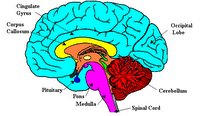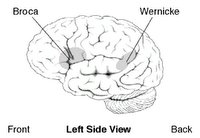 The idea that the left and right brain are functionally independent and asymmetrical originated from medical observations of stroke victims and other brain-injured persons. What physicians described were the differing symptoms caused by a brain injury to one side of the brain versus an injury to the homologous area on the other side.
The idea that the left and right brain are functionally independent and asymmetrical originated from medical observations of stroke victims and other brain-injured persons. What physicians described were the differing symptoms caused by a brain injury to one side of the brain versus an injury to the homologous area on the other side.
Pierre Paul Broca, for example, a scientist who studied the neurological basis of language, noted that a particular injury in a specific area on the left side of the brain did not cause the same disability when the exact same injury occurred on the right side. One patient with an injury in this area--described by Broca and now bearing his name--could understand everything that was spoken to him; but was unable to respond verbally except for the one word, "tan" uttered in answer to every question. This was probably the first described case that illustrated brain hemispheric lateralization.
Roger Sperry , who won the Nobel prize in 1981, and Michael Gazzaniga performed a series of "split brain" experiments on people who had undergone surgery to cut the large tract of millions of neurons that normally connect the left and right halves of the brain. This tract is called the corpus callosum, and it is sometimes severed surgically as a last resort to help people with very severe epileptic seizures.

 After surgery, the people who had undergone the callosotomy appeared quite normal and felt themselves to be completely unchanged. They were noted to be able to walk, read, talk, play sports and do all the everyday things they did before surgery.
After surgery, the people who had undergone the callosotomy appeared quite normal and felt themselves to be completely unchanged. They were noted to be able to walk, read, talk, play sports and do all the everyday things they did before surgery.But although things appeared quite normal to everyone, experiments demonstrated some subtle but significant alterations in these patients' perceptions of reality.
For example, in one experiment, a word "fork" would be flashed on the right side of a screen so that only the right hemisphere of the patient's brain could receive the information. The patient would be unable to say what the word was when asked. When asked to write what he saw, the patient's left hand would write the word "fork" -- but the patient would have no idea what he had just written!
Sperry concluded from all these experiments that because there was no connection and no communication between the two sides of the brain, the information presented to the right half could not convey the information it had learned to the left half.
Additionally, because there was already a "specialization" for speech on the left side of the brain--but not on the right, the patient could not verbalize what had just occurred.
Well, you may ask, what has this got to do with anything?
Other bizarre medical variations of this kind of disability occur regularly --albeit rarely--among neurological patients. I mentioned one such perceptually impaired person in a previous post to demonstrate how psychological denial can also be thought of as a disruption in the physical pathways of perception:
I once saw a remarkable patient with arelatively rare neurological diagnosis. He had suffered a stroke and one of his symptoms was that he did not acknowledge that the entire left side of his body was physically a part of him. It was an astonishing conversation our team had with him. "Is this your arm," the neurologist would ask him, pointing to the patient's left arm. "No, it's not mine," would be the reply. The neurologist would then take the man's arm and show him how it was connected with the rest of his body. The man would watch this, then shake his head and emphatically tell us, "No! I see that it is connected. Someone must have connected it when I wasn't looking. But it isn't my arm."
The evidence that it was his arm was before him. Because of physical damage to his brain, this gentleman was never able to be convinced that the arm on the left side of his body belonged to him.
Let us for a moment consider recent events and controversies about national security currently in the news. If we think about our national security information gathering capability as analogous to a functional human brain (after all, there is a reason why we refer to such activities as "intelligence") ; and allow that this intelligence-gathering capability has more than one agency or method (hemisphere) whose job it is to gather intelligence; then we can appreciate that each agency (hemisphere) has a specific and somewhat unique role in obtaining, analyzing, interpreting data that it may receive and transmitting that information to the whole.
Optimally, the overall national security "brain" performs its duties best when connections between the specialized intelligence organizations within its control are constantly relaying information both ways for consideration and verification by the other side. With the lines of communication open (an intact "corpus callosum"), information passes freely back and forth so that trends and individual facts known to one side or the other can be integrated into a whole pattern for use by those who want to protect this country.
What if, instead of the rich connections that should exist between the parts of the national security "brain", there existed a "wall"? If, for example, like the real human brain, the corpus callosum were shut down or were severed entirely? Those independent agencies would perform their usual duties-- talk, write reports, and behave completely normally to all observers; but in reality they would be as perceptually impaired as Sperry's patients--and just like those patients, they might not even be capable of realizing the serious deficit they must now live with.
The dust-up about the NSA wiretapping after 9/11 shows that there are powerful forces at work that are intent on maintaining the a wall and severing connections between the sides of our national security brain. These forces are obsessd with a need to prevent the sharing of information on any level.
Some of this obsession may be a reasonable fear of privacy concerns (a normal brain, too, must always discard the irrelevant data when integrating different types of information into patterns). Some of the concerns are merely power plays and the typical paranoia and jealousy of different government bureaucracies. Some of the obstacles that prevent information sharing are designed to deliberately keep one side from knowing what the other side is doing. And some of what is going on is a serious psychological illness that has been disrupting reason and judgement for several years now.
But the coordination of intelligence in the age of terrorism is absolutely essential for national security. It is incredibly important that we understand the origins and consequences of these intragovernment spats and power plays that seem to continually interfere with rational and competent intelligence gathering; and which sever connections between agencies which should be working together for the benefit of the whole.
Between them, the 1978 FISA enactment and the 1990's Gorelick "wall" set up barriers in both law enforcement and intelligene gathering agencies lines of communication and have have resulted in a brain-damaged intelligence gathering capability in this country.
Just as with Sperry's patients and his later experiments with animals, the information available to one side of the brain has been made off-limits to the other and as a result, the whole reality has been obscured-- and many of the people involved have been unable to perceive that anything was really wrong. Before 9/11 everything felt completely normal and hunky-dory because the various agencies had become used to their mandated limitations.
In the 1990's Jamie Gorelick along with her Clinton administration collaborators was the surgeon who performed the callosotomy on our collective intelligence-gathering capability. It seemed to function for all intents and purposes relatively normally-- right up until it was presented with a integrative task that was beyond the scope of an organism with half a brain.
But we need to fight this war with a whole brain.
Unlike the patients in my analogy, however, this situation does not have to be a permanent disruption of our perceptual abilities. It can and must be fixed. The lines of communication must be opened and data shared for the good of all.
Otherwise, we will continue to function like a patient with only half a brain.
No comments:
Post a Comment